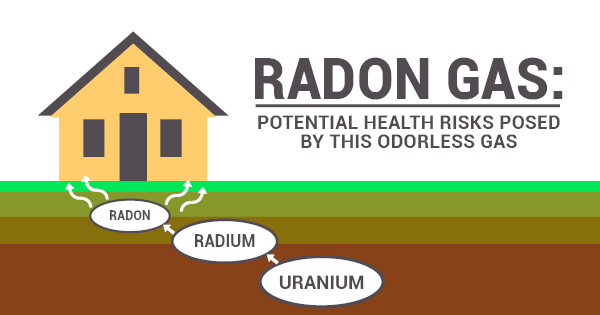
Radon gas is a radioactive gas that is tasteless, odorless, and colorless. Although radon gas is a naturally occurring substance that forms via the decay of radioactive elements in the earth, it can be extremely dangerous to a person’s health.
When radon gas makes its way into the air of a person’s house through a home’s foundation or into one’s drinking water, the radiation from the gas particles can cause detrimental damage to the person’s cells and DNA.
Radon gas and cancer
Radon poisoning is the second leading cause of lung cancer in the U.S. according to the Surgeon General. When high levels of radon gas are present in a home, the radioactive particles can attach to dust motes and then make their way into the lungs of any people or pets in the vicinity. However, because this gas is colorless, tasteless, and odorless, how can you know that your household is being exposed to radon in the first place?
Symptoms of radon poisoning from the air often resemble the symptoms of those suffering from lung cancer caused by smoking cigarettes. These symptoms include:
- Chest pain
- Difficulty breathing
- Wheezing
- Hoarseness
- Persistent cough
- Persistent cough with presence of blood
- Persistent respiratory infections
Radon gas can also be taken into the body via drinking water. This happens when radon is broken down in the soil and then makes its way into surface water such as lakes and rivers. However, in these instances, the level of radon is typically low. Higher levels of radon gas are often found in well water.
Those who drink water contaminated by radon gas will suffer from digestive problems that may lead to stomach cancer. Symptoms such as stomach pain, digestive issues, and cramps may be a sign of radon poisoning.
Detecting radon gas
Fortunately, despite radon gas’ tasteless, colorless, and odorless appearance it can be detected by a residential radon testing service at your convenience. Radon gas testing can be conducted two ways: long-term and short-term. If high levels of radon gas have been detected in your home, your radon testing contractor may suggest using a radon gas removal system for your own protection.
A radon gas removal system, also known as a radon mitigation system, reduces the radon in your home using a fan and a vent pipe system. The radon gas removal system pulls the radon out from beneath your home and ventilates the gas outdoors to depressurize the soil beneath your house’s foundation. This will keep high levels of radon gas from entering your home through the cracks and causing health concerns.
If you’re worried about high levels of radon gas in your home, contact the specialists at Affordable Radon Colorado today. With a radon test and removal, you’ll be able to breathe easy again.

Recent Comments